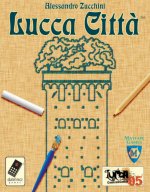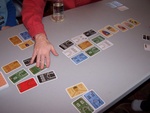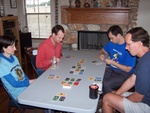
|
Lucca Città A game by Alessandro Zucchini Published by da Vinci Games and distributed in the US by Mayfair Games, Inc. Players: 3-5 Time: 20-30 minutes Reviewed by Ed Rozmiarek |

|
| "Italy, 1628: The wealthy families from the city of Lucca compete to build the most fabulous palaces while contributing to the reinforcement of the City Walls. But only the most successful family will be included in the "Gold Book" of the Republic, and could earn a place in the government of the City of Lucca!" |
Lucca Cittą is a set collecting card game themed around building palaces in Renaissance Italy. There are a large number of games based in this period of time with many of them building games. In fact, Palazzo is another recent game with a very similar theme and there is an older tower building game called Campanile.
Components:
- 96 Palace parts cards in six colors
- 4 tower cards
- 5 player "quarters" cards
- 5 player coats of arm cards
- Rules manual
The "quarter" cards are used to mark the players' work area. They divide it into three sections, the Palace Construction area, the Completed Palace area and the Open Palace area. The coat of arm cards are used to mark the player turn order.
The cards are fairly standard quality with only a plastic coating and do not have a linen finish. They come in a double size tuck box similar to Mama Mia, Coloretto and Tichu.
Game play:
The goal of Lucca Cittą is to score the most points by building the best palaces and by helping build the city wall. The players do this by collecting palace cards of the same color. Once the palace is of a certain size (based on the number of players), the palace is complete and scores points based on the number of windows in the palace. The owner of this brand new palace can then show it off by opening the palace and throwing a party (yes, a party). This scores additional points based on the other players' cards. At the end of the game, the players also score bonus points based on how much they helped in building the city wall. The player with the most points wins the game.
At the start of the game, the players get two cards with their family coat of arms on it. One will be used to mark player order for each turn and the other is placed in front of the player to define his building workspace. The players are also dealt four of the palace cards from the shuffled palace card deck. Of these cards, they will keep two for their initial building(s), discarding the other two which are shuffled back into the palace deck along with the four tower cards.
| Players | Cards per Palace | Rounds |
| 3 | 5 | 7 |
| 4 | 4 | 6 |
| 5 | 3 | 5 |
On a player's turn he does two things, open completed palaces and then pick and play a palace card triplet.
Opening Palaces
At the start of his turn, a player may open any palaces that were completed on a prior turn
and which have not yet been opened.
(Obviously, he will not be able to do this on the first turn of the game.)
If a player does this, he will score points based on the number of same colored
cards that the other players have in their play areas.
For each completed, but unopened, palace in the other players' play areas,
the newly opened palace will score two points.
In addition, the player will also score one point for each card of the same colored palaces
that are under construction by the other players.
The other players' opened palaces provide no additional score for the newly opened palace.
Playing a Triplet
After opening any palaces, the player must pick one of the palace card triplets on the table and play the three cards,
in any order he wishes.
There are several options for playing cards.
- Start a new palace: The player may start a new palace in the construction area of their play area. The player may only have one palace of each color in their entire play area (under construction, completed or opened).
- Add to an existing, uncompleted palace: The player may add additional cards to any uncompleted palaces he has under construction. The palaces are complete as soon as the required number of cards are played to the palace (see table above). Each palace may only contain cards of a single color. The new cards are placed on top of the previous palace cards such that the shields and windows are visible but the street number of only the last card played is visible. When a palace is complete, the player will score it. He gets one point for each window in the completed palace. The completed palace is then moved to the Complete Palace area (to the left of the players work area).
- Add to the city wall: If the player does not wish to or can not use a palace card to build a palace, he may turn it into a city wall segment that may provide an end game bonus for the player. He does this by placing the card upside down in his Completed Palaces section of his work area.
- Build a tower card: There are four tower cards that are shuffled into the palace card deck. If a player picks a triplet with a tower card, he places the tower card in his Completed Palaces area. These cards may provide an end game bonus like the city walls. However, tower cards do not need to be "supported" like city walls (see end game scoring below).
- Discard the card: If the player has no use for one or more cards of the triplet he picks, they may be discarded out of the game.
At the end of the game, three additional scorings occur. First, player order is determined one last time, again based on the shields of the players' uncompleted palaces. The players then must open all remaining completed, unopened palaces. This is done in player order, so going first here will generally score more points if the other players have unopened palaces.
After opening palaces, the players score a bonus for their city walls and towers. However, to do so, the player first must be able to support the city wall segments he built. To support them, for each wall segment the player built, the player must have two support shields on the cards for the uncompleted palaces left in his play area. If he cannot support the wall segments, the player scores no bonus. (Note that towers do not need to be supported.) If the player can support their wall segments, he will get a bonus equal to his total number of wall segments and towers times the number of completed palaces he has.
Finally, the player with the lowest visible street number must give the player with the highest visible number three points.
Comments:
Lucca Cittą is a light to medium weight set collecting game.
It's a step up from light games like King's Breakfast or Coloretto but it's
less complicated than the other recent tower building game, Palazzo (which I consider a middle weight game).
Lucca Cittą provides some nice set management decisions, mainly in the shields vs. windows trade-offs.
More shields will get you a better position in the turn order and will support walls at the end of the game,
but windows score points. Players need to balance when to get each during the game.
Also, since each player can only have one palace of each color, you want to only get cards you can use.
Being able to use unwanted cards as wall segments helps and can provide a good bonus at the end.
However, you need to be able to support those walls which will tie up more cards with shields for uncompleted palaces.
The timing of opening palaces provides yet another area for player decisions. You want to leave your completed palaces unopened until it will score the most points. However, if you leave it too long, the other players may complete or open their palaces, thus reducing your points. I have found you need to match what the other players are building and what they might complete that round to time the opening of your palaces well. Also, if you leave the openings until the end of the game, you may not score well, especially if you are late in the final turn order. Definitely lots of decisions there. Granted, the decisions aren't as deep as some games and you can get messed with the card selection in any round, but it is nice for a 30 minute game.
Lucca Cittą is one of the better games from daVinci. The game play is light but engaging, the mechanisms are fairly straightforward and fit the theme and the theme itself, although a little repetitive, is recognizable. daVinci is definitely aiming for the family market and I think that Lucca Cittą will go over well with that market. I can see playing this with "non-gamers" as a step up from light games to something with a little more meat to it. Regular gamers should find it enjoyable as a 20 to 30 minute filler or lunch time game that provides some decent decisions but isn't going to tax your brain.
One thing I keep seeing is that many family gamers are looking for non-confrontational games. Ones that the players don't attack other players directly but yet their actions influence the other players' moves. Lucca Cittą fits that bill well as the players compete for turn order to get better card selection and score points based on the other players' cards when they open palaces.
Given the relatively low price of Lucca Cittą, it is well worth checking out as I think you will get a good bang for the buck game-wise.
| Other Web information: |
This page viewed
E-mail Ed Rozmiarek with questions or problems concerning this page.
Copyright © 2006, Ed & Susan Rozmiarek. No portion of this website may be reproduced or copied without the consent of Ed or Susan Rozmiarek.


